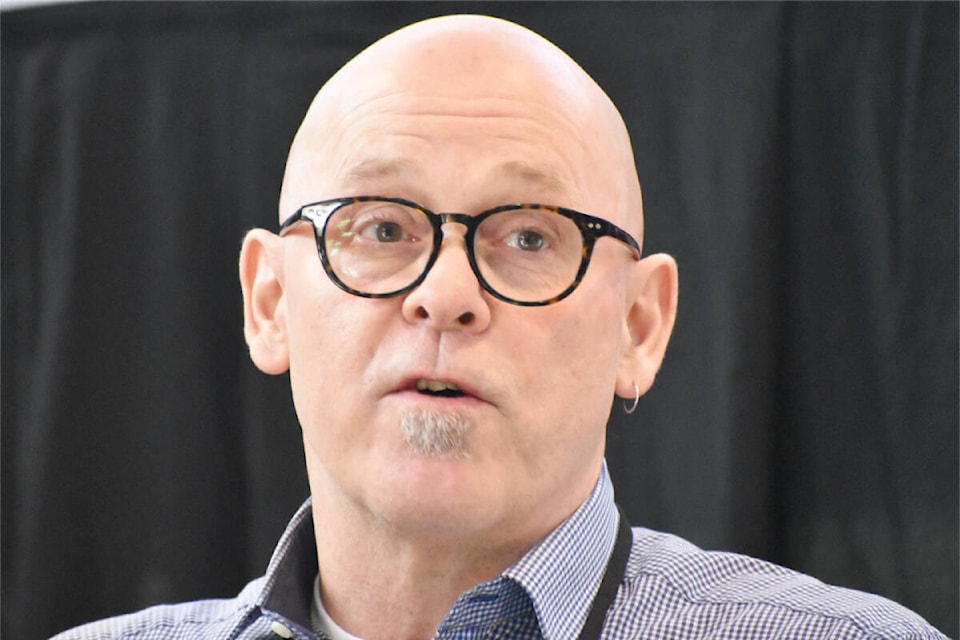This is not a simulation. Real, actual experts in forest industry education are eyeing a Burns Lake asset with hope and interest.
Burns Lake Community Forest has one of only three special simulation units in B.C. that teach the ways of operating a Ponsse forwarder-harvester. They use that kind of machine to do some of their timber cutting, hauling, and processing. These machines do all that, and their rubber tire design allows them to tiptoe through a forest landscape, rather than the bull in the china shop effect of past harvesting machinery British Columbia’s loggers are used to using.
During a forestry think tank held in Quesnel May 2 and 3, an array of stakeholders involved in the forest sector held a series of conversations examining the future of B.C.’s backbone industry. Two of the speakers separately brought up the importance of that simulator in Burns Lake.
Of them was someone who has one of the three, himself. Dominik Roeser is an author, researcher, the former senior director of FP Innovations, and is now an associate professor at UBC’s school of forestry, specializing in forest operations.
“I just got mine a couple of months ago,” he told Black Press. “We’re starting to build a research program around it and then the idea is to bring it into communities so people get more comfortable (with operating the machines) and learn what to watch out for. But (at a post-secondary institution in Oregon) they have 20,” so the three in B.C. are already precious training commodities. Prince George is where the third one is located, in the hands of a Ponsse dealer. Could it be contracted out to a school?
“As Dominik said, there are three in the province and we are in proximity to two of them,” said Douglas Jamieson, director of regional education for the College of New Caledonia. “So we are keen to try to figure those things out: how do we make something more happen out of that? If I reach out (to the two simulator owners), have that conversation, I’m hoping it’s something we can get access to. We do not have a program, right now, but absolutely we are very interested. As capacity or demand grows to do that work in the forests, as that evolves, that’s where we get active. We are where people could go to train. Pablo (Crespell, CNC’s research fellow specializing in the wood industry) has some ideas around applied research - how we can maximize our usage.”
Why the sudden interest, provincially, in simulators like these? The forest industry is now like the airline industry in one important way. If you’re teaching pilots, you don’t want to hand them a million-dollar jet aircraft to go for their first test drive. You want them to make the inevitable mistakes of learning on a computer program with a reset button. Those forwarder-harvester machines are as expensive as a lot of commercial planes.
“Driving these machines is super complicated; you’re having to make decisions all the time,” said Roeser. But for the B.C. forest industry to thrive, these are the machines loggers will be driving - not loggers of the distant future, but in many cases right now.
“That’s what I’ve been working on with (think tank organizers) Erin (Robinson) and Bob (Simpson), and CNC,” he said, but the most obvious hurdle is immediate employment opportunities. If they pump out these specially trained students, is there a forest company waiting at the other end to hire them?
“It’s the chicken and egg thing,” said Roeser, who said the B.C. forest industry is already having to source out-of-province operators being flown in from New Brunswick and Quebec so an experienced operator can sit in the seat of what relatively few forwarder-harvester machines are already in operation. But more timber companies and First Nations are testing the machines out, and the factors are lining up in their favour. In many ways, B.C. is far behind and having to catch up to jurisdictions in every direction.
“It’s because we’re changing the forest harvesting system from a clearcut system, which we are very good at, to a thinning (aka selective logging) system, which we are not very good at,” said Roeser. “You need different technologies, different approaches, and those machines are used in the thinning system. So as we are ramping up in the thinning system, we will need more operators. We don’t want to always be flying them in. It’s exciting to be there at these moments of positive change moving forward.”
